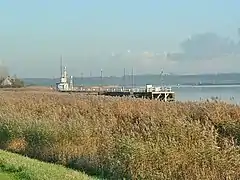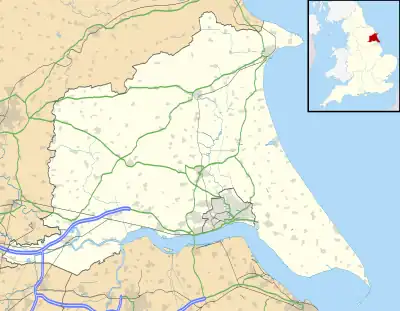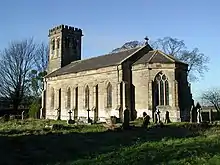Blacktoft
Blacktoft is a village and civil parish in the East Riding of Yorkshire, England. The village is situated on the north bank of the River Ouse, 1 mile (1.6 km) west from where it joins the River Trent and becomes the Humber. It is approximately 6 miles (10 km) east from Howden and 23 miles (37 km) south-east from the county town of York. Blacktoft lies within the Parliamentary constituency of Haltemprice and Howden an area that mainly consists of middle class suburbs, towns and villages. The area is affluent, placed as the 10th most affluent in the country in a 2003 Barclays Private Clients survey,[2] and has one of the highest proportions of owner-occupiers in the country.[3]
| Blacktoft | |
|---|---|
 Blacktoft Wharf, on the banks of the River Ouse | |
 Blacktoft Location within the East Riding of Yorkshire | |
| Population | 322 (2011 Census)[1] |
| OS grid reference | SE842242 |
| • London | 150 mi (240 km) S |
| Civil parish |
|
| Unitary authority | |
| Ceremonial county | |
| Region | |
| Country | England |
| Sovereign state | United Kingdom |
| Post town | GOOLE |
| Postcode district | DN14 |
| Dialling code | 01430 |
| Police | Humberside |
| Fire | Humberside |
| Ambulance | Yorkshire |
| UK Parliament | |
The civil parish of Blacktoft consists of the village of Blacktoft, Bellasize, Faxfleet and Yokefleet. According to the 2011 UK Census the parish had a population of 322,[1] an increase of one on the 2001 UK census figure.[4]
Blacktoft Sands RSPB reserve lies across the Ouse. The relatively new island of Whitton Island in the Humber Estuary falls partly within the parish.[5]
History
According to A Dictionary of British Place Names, Blacktoft's joint derivation is from the Old English with Old Scandinavian for "dark coloured homestead." In c. 1160 it was recorded as "Blaketofte."[6]
In 1823 Blacktoft was in the wapentake of Howdenshire. It had a population of 268, with occupations including two farmers, a corn miller, blacksmith, tailor, shoemaker, and a carpenter, and a coal dealer who was also the landlord of the Bay Horse public house. Professions included a church curate. There were two surveyors of highways providing for the maintenance of parish roads. The village had a chapel and its own parish constable. At that time on the opposite bank of the Ouse, "great quantities" of river vessels were at times docked in what was considered good anchorage, and steamboats passed on the route between Selby or Thorne and Hull. Low tide exposed sand beds, the sand from which was used as ballast for small craft.[7]

The church, dedicated to the Holy Trinity, was designated a Grade II listed building in 1966 and is now recorded in the National Heritage List for England, maintained by Historic England.[8] The church was constructed in 1841 by John Harper, of ashlar masonry with a west tower, Perpendicular-style windows, and a nave with apse at the east.[9] The stability of a previous Blacktoft church was causing concern in the early 1740s. A contemporary court report noted that the chancel of the church had been re-built to a lower height than one existing earlier, resulting in a gap between the top of the new chancel and nave. This gap was closed by stooths—wooden studs or battens—on the exterior of the nave supporting a beam. The court heard that the earlier higher chancel roof had collapsed in the early 1660s as the congregation were leaving the church—this information was treated with scepticism by a prosecutor, but was supported by local masons and carpenters.[10]
In 1842 Blacktoft ecclesiastical parish covered an area of 2,730 acres (11 km2), and had a population of 394. The parish register dated from 1700. The Chapelry of Blacktoft had been held by the Bishop of Durham and Durham Monastery—who provided for a stipendiary (paid) priest—up to the reign of Edward VI, this afterwards being granted to a William Jobson, a Hull merchant, who became lay patron (impropriator) of Blacktoft incumbent clergy. Patronage reverted to the Dean and Chapter of Durham Cathedral during the reign of George I.[11]
In the late 18th century the inclosure of land at Blacktoft was enacted by act of Parliament. A further Blacktoft land inclosure act was placed before Parliament in 1830, with this act including the lands of Gilberdyke and Faxfleet.[11][12]
In early December 2013 Blacktoft, among other regional settlements including Reedness, Saltmarshe, North Ferriby, Hessle and Kingston upon Hull and many more, was subject to flooding due to a tidal surge on the Humber, the largest in 60 years. According to the Environment Agency, damage caused would have been worse had it not been for the Hull Tidal Surge Barrier. A 2014 Flood Investigation Report from East Riding of Yorkshire Council recommended that affected property owners should "develop a personal flood plan".[13][14] However, improved flood defences are likely to be introduced across the Humber Estuary including the significant raising of the river bank in order to ensure such flooding does not happen again. The Environment Agency expressed confidence in such flood defences being improved by the government in order to prevent flooding re-occurring in the Haltemprice and Howden constituency and across the East Riding of Yorkshire.[15]
References
- UK Census (2011). "Local Area Report – Blacktoft Parish (1170211147)". Nomis. Office for National Statistics. Retrieved 15 February 2018.
- "North tops 'real' rich league". BBC News. 14 May 2003. Retrieved 4 July 2014.
- "Haltemprice and Howden". UK Polling Report. Archived from the original on 18 May 2015. Retrieved 11 May 2015.
- UK Census (2001). "Local Area Report – Blacktoft Parish (1543504194)". Nomis. Office for National Statistics. Retrieved 26 November 2018.
- Ordnance Survey 1:25,000 scale Explorer mapping. Retrieved 31 October 2014
- Mills, Anthony David (2011) [2003]. A Dictionary of British Place Names (revised ed.). Oxford University Press. p. 61. ISBN 978-0199609086.
- Baines, Edward; History, Directory & Gazetteer of the County of York 1823, volume 2, p.168. Retrieved 4 July 2014
- Historic England. "Church of Holy Trinity (1346686)". National Heritage List for England. Retrieved 20 November 2013.
- Pevsner, Nikolaus; The Buildings of England. Yorkshire: York and the East Riding p. 193; Penguin (1972); reprinted 1975, Pevsner Architectural Guides. ISBN 0140710434
- Purvis, J. S. (1958); The Condition of Yorkshire Church Fabrics, 1300–1800, Issue 14 pp.22–23, Borthwick Institute of Historical Research. ISBN 9781904497363. Quoted 1792 court text. Retrieved 5 July 2014
- Lawton, George (1842); Collectio Rerum Ecclesiasticarum de Diœcesi Eboracensi: Or Collections Relative to Churches and Chapels, Volume 2, pp.329–330. Retrieved 5 July 2014
- Statutes of the United Kingdom of Great Britain and Ireland, 1830, Volume 70, p.19. Retrieved 5 July 2014
- "East Riding of Yorkshire report into December tidal surge accepted". BBC News. 24 June 2014. Retrieved 4 July 2014.
- "Flood Investigation Report – Tidal Surge on 5 December 2013" Archived 14 July 2014 at the Wayback Machine, East Riding of Yorkshire Council, 24 June 2014. Retrieved 4 July 2014
- "Minutes of the meeting", Blacktoft Parish Council, 17 February 2014. Retrieved 5 July 2014
- Gazetteer — A–Z of Towns Villages and Hamlets. East Riding of Yorkshire Council. 2006. p. 4.
External links
![]() Media related to Blacktoft at Wikimedia Commons
Media related to Blacktoft at Wikimedia Commons
- The ancient parish of Blacktoft: historical and genealogical information at GENUKI.
- RSPB Blacktoft Sands. Retrieved 5 July 2014
- Blacktoft Parish Council. Retrieved 5 July 2014
- "History of Blacktoft, East Yorkshire", Howdenshirehistory.co.uk. Retrieved 5 July 2014
- Blacktoft Beacon District Scouting. Retrieved 17 March 2015